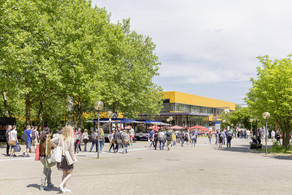DFG project: A modular framework for modeling mobility behavior in wireless networks considering varying data granularity (2016-2019).
The adequate and realistic modeling of the traffic load is a crucial step when building stochastic models of computer networks. With the increased availability of mobile devices performance evaluation of wireless networks has become more important. For a realistic load modeling in wireless networks the user mobility has an essential role.
The user movement patterns can either be generated synthetically or based on real data. While generating mobility models based on real data is much more elaborate, the resulting models have shown to be more realistic than synthetically generated ones. One issue with the creation of mobility models from real data stems from the granularity of the available data. Data that is recorded at WLAN access points does not contain information about exact movement patterns, only a mapping from users to access points is possible. However, data that allows for a more accurate determination of a user's position has been obtained from smaller user populations in the past. Different approaches for modeling user mobility have been developed that depend on the granularity of the data and on the goal of the analysis. A drawback of these approaches is that they cannot be used for different scenarios without problems.
Therefore, the project aims at developing a modular framework that meets the requirements of varying data granularity and different goals for an analysis. The mobility models that are part of the framework should be able to represent user mobility at different levels of abstraction and should be extendable to increase the level of detail easily.
Thus, the framework should provide a basis to compare the effect of different levels of abstraction for user mobility on performance measures.
Combining Mobility Models with Arrival Processes
Mobility models usually assume a constant number of mobility nodes for the simulation. Although in real-world scenarios new nodes will arrive and other nodes will leave the simulation area, only little attention has been paid to modeling these arrivals and departures of nodes.
In [1] we have presented an approach to combine mobility models with stochastic processes to account for the arrival and departure of nodes during simulation. The approach works on the generated scenarios and thus, can easily be combined with any mobility model. Arrivals and departures of mobility nodes occur in many real world scenarios (like airports, shopping centers, parts of an university campus) and our experimental study suggests, that modeling of arrivals and departures can have a significant effect on the performance results.
Spatial node distribution without arrivals (left), with arrivals (center), queueing results for models with and without arrivals (right).
[1] Jan Kriege: Combining Mobility Models with Arrival Processes. Proc. of MMB & DFT, 2016.
In discrete event systems event times are often correlated among events of one event stream and also between different event streams. If this correlation is neglected, then resulting simulation models do not describe the real behavior in a sufficiently accurate way. In most input modeling approaches, no correlation or at most the autocorrelation of one event stream is considered, correlation between different event streams is usually neglected.
In [2] we present an approach to combine multi-dimensional time series and acyclic phase type distributions as a general model for event streams in discrete event simulation models. The paper presents the basic model and methods to determine
its parameters from measured traces.
The approach is then used to model real-world traffic traces including a trace from a wireless scenario that contains the locations (access points), dwelltimes and traffic amount from users of a wireless network.
Queue length distribution of a router in a wireless network
- [2] Jan Kriege, Peter Buchholz: Traffic Modeling with Phase-Type Distributions and VARMA Processes. Proc. of QEST 2016.
With the increased availability of wireless networks, performance evaluation of these networks has become more important in recent years. Adequate models of wireless networks have to account for the user mobility as the movements of the users can have a large influence on the network performance. In many cases data recorded from real networks serves as basis to model the
user mobility. Therefore, appropriate distributions have to be found to model characteristics like dwelltimes from the real world data and different general distributions like Lognormal, Weibull or Pareto have been used in the past.
In [3] we present an extensive comparison for the fitting quality of those general distributions with Phase-type distributions (PHDs).
It is shown, that in most cases even small PHDs with four or five states are sufficient to obtain better results than general distributions widely used in the literature. This could be observed for coarse-grained and fine-grained data. When the trace data exhibits autocorrelation the fitting quality can be further improved by expanding the PHDs into MAPs, although this of course increases the effort for fitting.
Comparison of scaled log-likelihood values for general distributions, PHDs and MAPs
- [3] Jan Kriege: Markovian Modeling of Wireless Trace Data. Proc. of ValueTools 2017.






